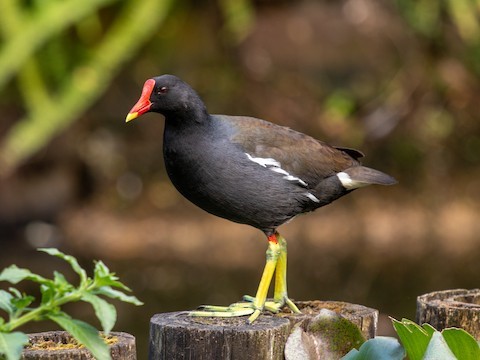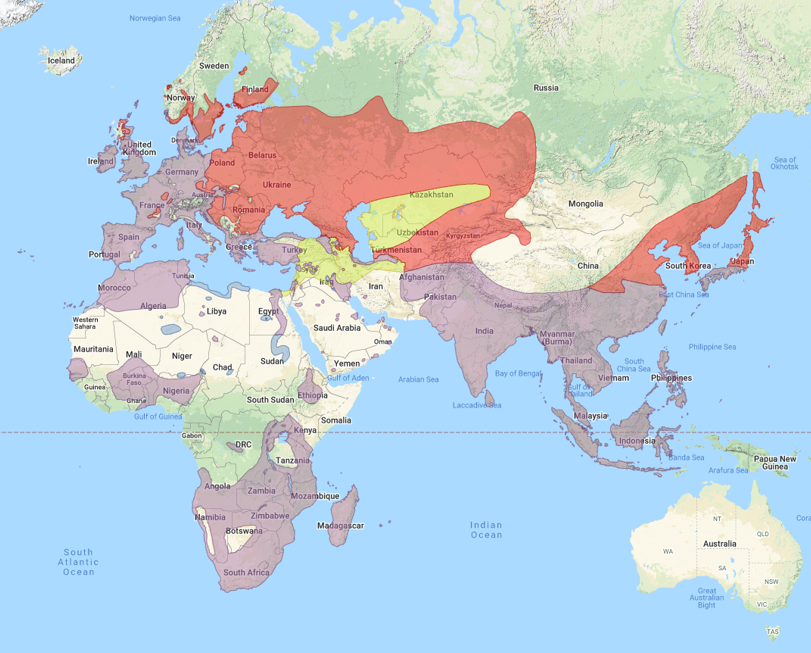Birdfinding.info ⇒ Common and conspicuous in many parts of its large range—especially in western Europe, the Mediterranean, and Taiwan, where it is locally abundant.
Eurasian Moorhen
Gallinula chloropus
Eurasia and Africa, in ponds, lakes, and wetlands with a mix of open water and emergent vegetation.
In Eurasia, breeds throughout most of Europe from Scotland and southern Scandinavia south to the Mediterranean coasts and islands, and east across most of western Russia and the former Soviet republics, southern Siberia, Mongolia, and China, to Amur, Japan, and possibly Sakhalin.
Populations of the north and continental interior are partly migratory, wintering across most of western Europe north to southernmost Norway and western Poland, and across most of East Asia north to the Yellow Sea coasts and southern Japan, but withdrawing from most of eastern Europe and the taiga and steppe zones of Asia.
Resident locally across southern Asia from Turkey east across the Middle East, then widespread from Pakistan east across central and eastern China to Taiwan, southern Japan, the Philippines, and Indonesia east to Sulawesi and Timor.
In Africa, resident in most regions where suitable habitat exists: locally across North African coastal lowlands, tropical West Africa, the Nile Valley, East Africa from Ethiopia south, and most of southern Africa.
Resident on Madagascar and several Indian island groups, including the Comoros, Seychelles, Mauritius, Réunion, and Diego Garcia.
Resident throughout Macaronesia, apparently on all islands with suitable habitat in resident in the Azores, Madeira, and the Canary Islands, and locally in Cape Verde (Santiago, São Vicente, and Boa Vista).
Also resident on some island groups of the western Pacific, including Palau and the Marianas.

Eurasian Moorhen. (Parc Japiot, Lorraine, France; November 21, 2018.) © Stefano Ianiro
Becomes more numerous and widespread in North Africa and southern Asia during the northern winter.
In spring, overshooting migrants regularly wander north to Iceland, the Faeroes, and northern Scandinavia, and likely also north of the usual Russian breeding range.
In the Americas, it has been recorded as a vagrant from Alaska once (Shemya Island, October 14, 2010), but seems likely to stray (especially to Newfoundland) but remain undetected due to its strong similarity to the Common Gallinule.
Identification
The widespread, familiar moorhen of Eurasia and Africa: a large, plump, aquatic rail that often swims like a duck.
Predominantly black or blackish overall with a bold red bill, white undertail coverts, and white streaks on the flanks.
The bill and frontal shield are strikingly vivid red with a yellow tip. The eye is dark-red—usually requires direct illumination to detect.
The back and wings are usually brownish, but the extent and tone vary from warm-brown to black.
The legs are mostly greenish, but partly red above the “knees.”
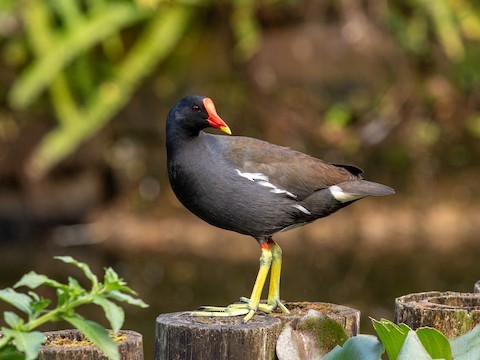
Eurasian Moorhen. (Taipei Botanical Garden, Taiwan; February 24, 2020.) © Eric Kuo

Eurasian Moorhen. (Slimbridge Wetland Centre, Gloucestershire, England; October 19, 2013.) © A. Emmerson

Eurasian Moorhen, showing red tone in eye. (Brüglingen Botanischen Gartens, Basel, Switzerland; October 16, 2019.) © Maryse Neukomm

Eurasian Moorhen. (Kiessee, Göttingen, Niedersachsen, Germany; April 17, 2020.) © Volker Hesse
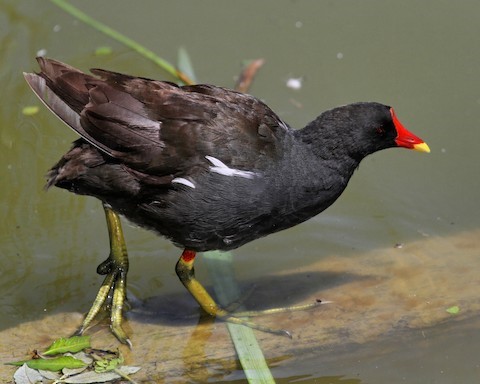
Eurasian Moorhen, showing dark-brown upperparts. (Parc des Oiseaux, Rhône-Alpes, France; July 25, 2012.) © Ian K. Barker

Eurasian Moorhen, showing all-blackish upperparts and unusually large frontal shield. (Danau Buyan, Bali, Indonesia; September 12, 2018.) © ASalafa Deri

Eurasian Moorhen, showing warm-brown upperparts. (Taipei Botanical Garden, Taiwan; March 17, 2019.) © Arlango Lee

Eurasian Moorhen. (Sefton Park, Merseyside, England; March 11, 2019.) © Elliot Montieth

Eurasian Moorhen, showing all-blackish upperparts. (Central Park, Kaohsiung, Taiwan; April 18, 2019.) © Eyzat Amer

Eurasian Moorhen. (Helston, Cornwall, England; November 24, 2015.) © Terry Woodward
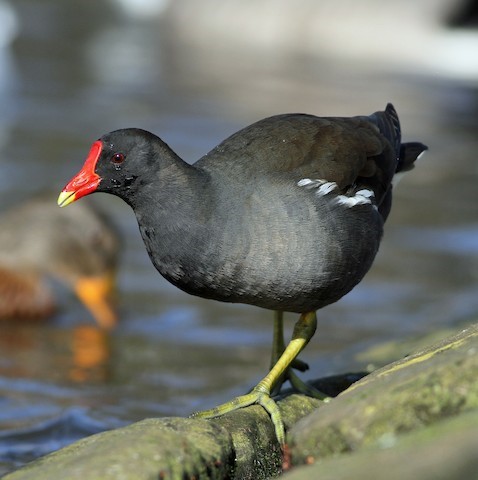
Eurasian Moorhen. (Sefton Park, Merseyside, England; March 11, 2019.) © Elliot Montieth

Eurasian Moorhen. (Inverleith Park, Edinburgh, Scotland; January 31, 2015.) © Lukasz Pulawski

Eurasian Moorhen. (Arundel, West Sussex, England; November 15, 2008.) © Tomasz Doron

Eurasian Moorhen. (Portishead Seafront, Somerset, England; December 16, 2012.) © Paul Chapman

Eurasian Moorhen, appearing round-bodied. (London Wetland Centre, London, England; January 11, 2019.) © Paul Lewis
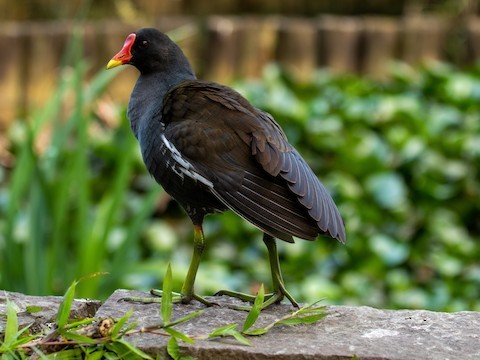
Eurasian Moorhen. (Taipei Botanical Garden, Taiwan; February 24, 2020.) © Eric Kuo

Eurasian Moorhen. (Bozem Wonorejo, Java, Indonesia; September 1, 2014.) © Rusman Budi Prasetyo
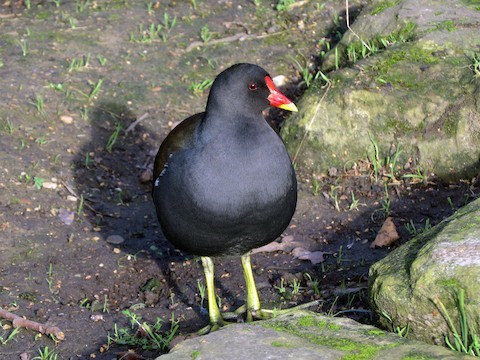
Eurasian Moorhen. (Regent’s Park, London, England; December 26, 2016.) © Daniel Matamoros
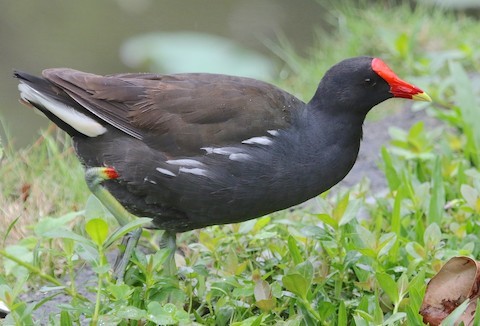
Eurasian Moorhen, showing its red thigh. (Taipei Botanical Garden, Taiwan; April 24, 2017.) © Gil Ewing
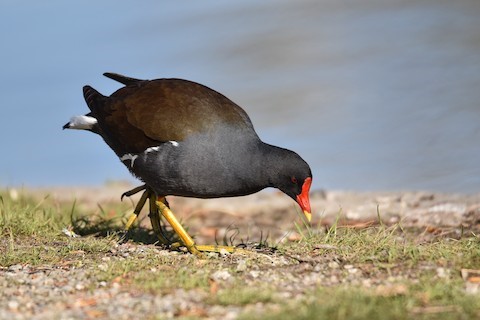
Eurasian Moorhen, showing its red eye. (Brüglingen Botanischen Gartens, Basel, Switzerland; March 29, 2019.) © Maryse Neukomm
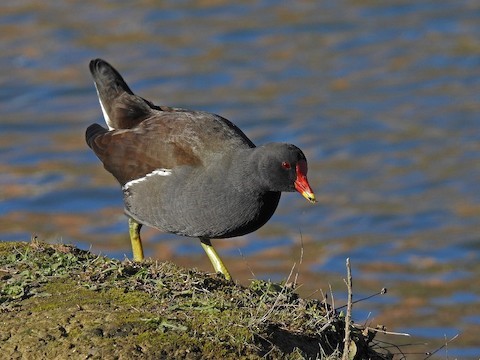
Eurasian Moorhen, showing its red eye. (Mendillorri, Pamplona, Spain; December 20, 2017.) © Javier Robres
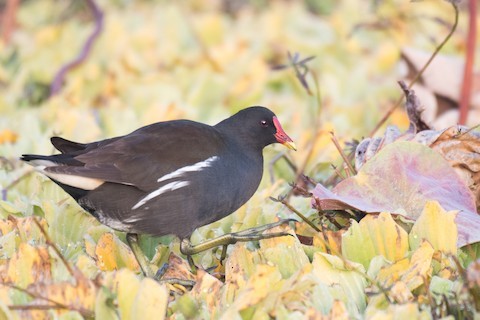
Eurasian Moorhen. (Nagdaha, Lalitpur, Madhyamanchal, Nepal; December 10, 2020.) © Ian Hearn
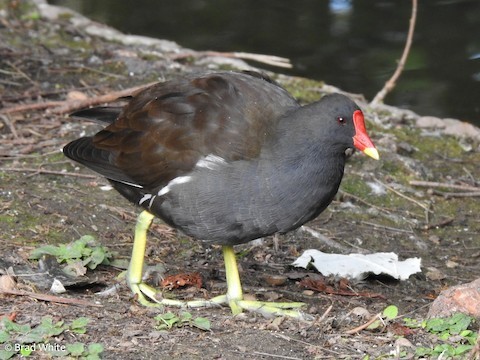
Eurasian Moorhen, apparently well-fed. (Hofgarten, Düsseldorf, Nordrhein-Westfalen, Germany; August 29, 2018.) © Brad White
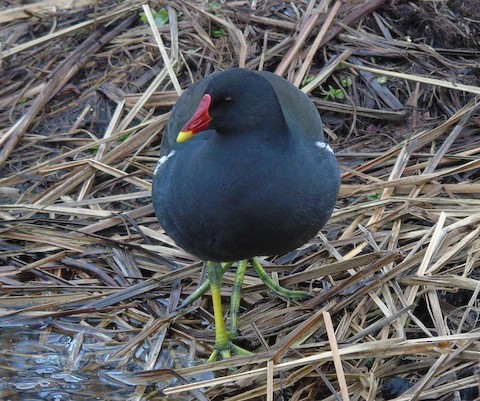
Eurasian Moorhen. (Inverleith Park, Edinburgh, Scotland; January 31, 2015.) © Lukasz Pulawski

Eurasian Moorhen, adult sheltering downy chick. (Grand Canal at Charlemont, Dublin, Ireland; May 5, 2017.) © Tanya Girod
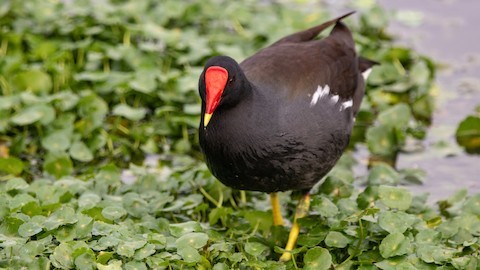
Eurasian Moorhen, with an unusually large frontal shield. (Da’an Forest Park, Taipei, Taiwan; January 31, 2019.) © Darren Hsu

Eurasian Moorhen, appearing very pale, perhaps subadult. (Mallorca, Spain; October 20, 2013.) © Juan José Bazan Hiraldo
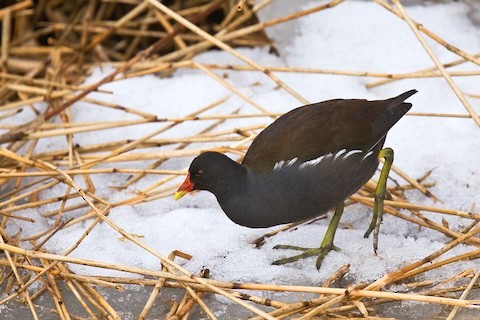
Eurasian Moorhen, showing tolerance for northern winter. (Aarhus, Denmark; February 28, 2010.) © Henrik Bringsøe

Eurasian Moorhen. (Taipei Botanical Garden, Taiwan; August 9, 2019.) © Tom Liao

Eurasian Moorhen. (Campania, Italy.) © Ciro de Simone

Eurasian Moorhen. (Redesmere, Cheshire, England; February 23, 2019.) © A. Emmerson

Eurasian Moorhen. (Clissold Park, London, England; February 22, 2017.) © Stephen Harris

Eurasian Moorhen. (Taipei Botanical Garden, Taiwan; March 17, 2019.) © Arlango Lee

Eurasian Moorhen. (Slimbridge Wetland Centre, Gloucestershire, England; March 11, 2012.) © Simon Bradfield

Eurasian Moorhen. (Brüglingen Botanischen Gartens, Basel, Switzerland; October 16, 2019.) © Maryse Neukomm

Eurasian Moorhen. (Marievale Bird Sanctuary, Gauteng, South Africa; July 6, 2018.) © Dan Vickers
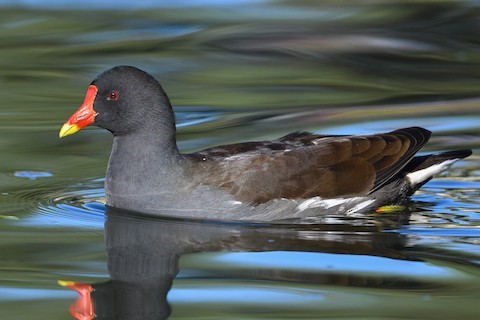
Eurasian Moorhen. (Brüglingen Botanischen Gartens, Basel, Switzerland; October 16, 2019.) © Maryse Neukomm

Eurasian Moorhen. (Hyde Park, London, England; October 16, 2016.) © David Kirsch

Eurasian Moorhen. (Abu Nakla Sewage Treatment Plant, Ar Rayyan, Qatar; June 26, 2009.) © John Thompson
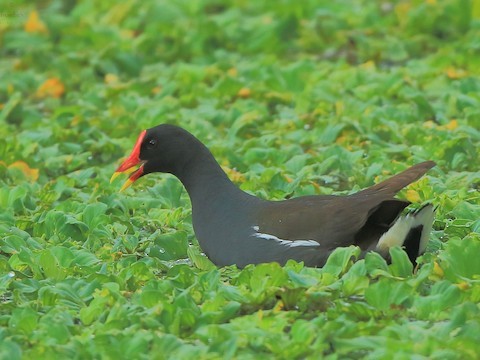
Eurasian Moorhen. (Indian Botanic Garden, Kolkata, Haora, West Bengal, India; July 9, 2017.) © Arnab Pal
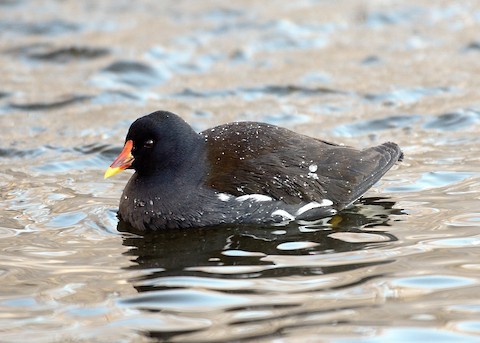
Eurasian Moorhen. (Lötsjön, Sundbyberg, Sweden; January 22, 2013.) © Hans Norelius
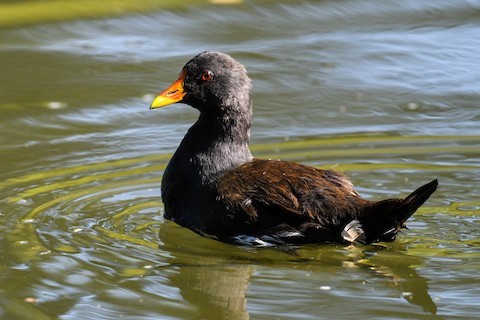
Eurasian Moorhen, likely a subadult with atypical bill coloration. (Kaiseraugst, Basel, Switzerland; August 5, 2020.) © Maryse Neukomm
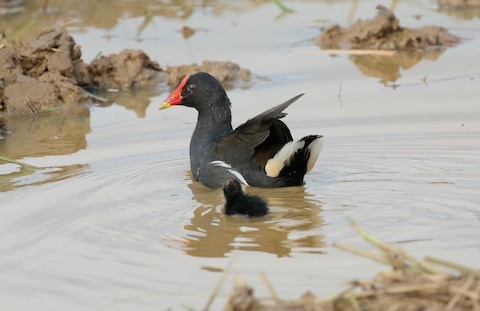
Eurasian Moorhen, adult with downy chick. (Batang Tiga, Melaka, Malaysia; August 30, 2017.) © Neoh Hor Kee

Eurasian Moorhen. (Tymon Park, Dublin, Ireland; December 16, 2019.) © Grzegorz Burkowski
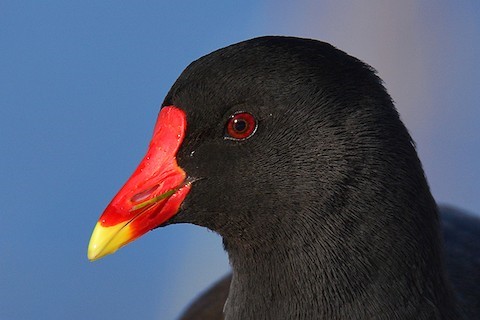
Eurasian Moorhen. (Phoenixsee, Dortmund, Nordrhein-Westfalen, Germany; February 1, 2019.) © Guido Bennen
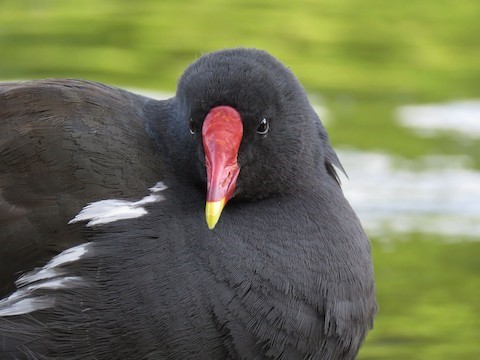
Eurasian Moorhen. (St. James’s Park, London, England; June 16, 2019.) © David Scott
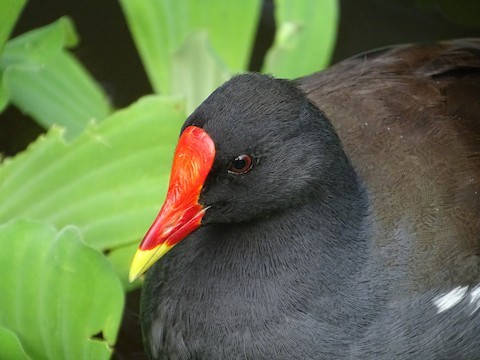
Eurasian Moorhen. (Taipei Botanical Garden, Taiwan; August 9, 2019.) © Tom Liao
Immature Plumages. Immatures resemble adults but have more muted coloration: gray overall with brown back and wings and a dull brownish, pale-tipped bill.
Subadults go through a stage when they have mostly adult plumage but the bill is dull and shieldless. The bill then grows the frontal shield and flushes with the bright red and yellow of adulthood.

Eurasian Moorhen, subadult. (Taipei Botanical Garden, Taiwan; October 16, 2017.) © Forest Jarvis
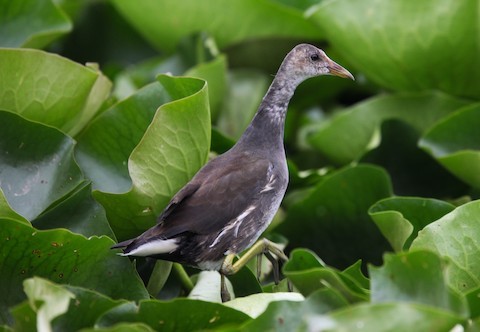
Eurasian Moorhen, immature. (Dal Lake, Srinagar, Jammu & Kashmir, India; June 29, 2010.) © Pam Rasmussen
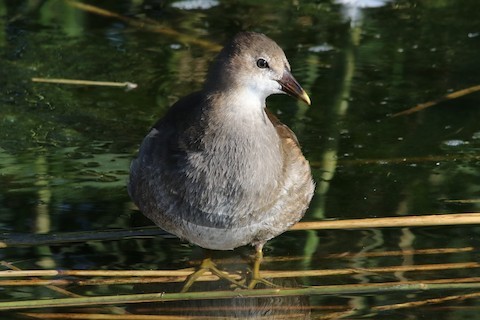
Eurasian Moorhen, immature. (Zelenogradsky, Kalingrad Oblast, Russia; September 28, 2017.) © Tatyana Korzhitskaya

Eurasian Moorhen, immature. (Porto, Portugal; October 14, 2017.) © Luis Rodrigues

Eurasian Moorhen, immature. (Porto, Portugal; September 30, 2017.) © Luis Rodrigues

Eurasian Moorhen, subadult. (Gallikos River Delta, Macedonia, Greece; December 22, 2018.) © Theodosis Mamais

Eurasian Moorhen, immature. (Laguna de Navaseca, La Mancha, Spain; September 1, 2020.) © Dirk Engelen

Eurasian Moorhen, immature. (Nagdaha, Lalitpur, Madhyamanchal, Nepal; December 10, 2020.) © Ian Hearn
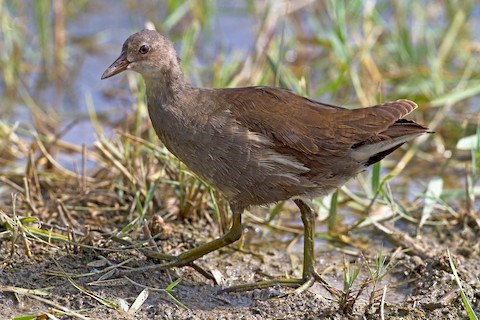
Eurasian Moorhen, immature. (Rome, Italy; September 22, 2012.) © Marco Valentini

Eurasian Moorhen, immature. (Planten un Blomen, Hamburg, Germany; September 4, 2018.) © Eric VanderWerf

Eurasian Moorhen, immature. (Porto, Portugal; September 30, 2017.) © Luis Rodrigues

Eurasian Moorhen, subadult. (Lodmoor RSPB Reserve, Dorset, England; September 16, 2019.) © Colin Lamond

Eurasian Moorhen, subadult. (Heusenstamm, Hessen, Germany; September 12, 2019.) © Stefan Gleissburg
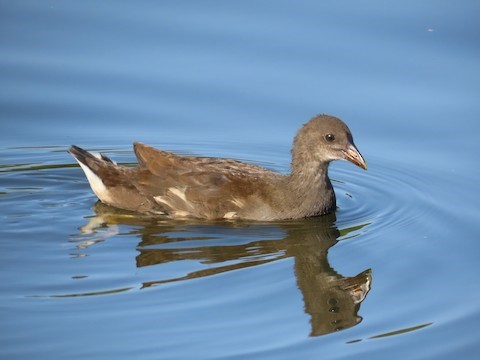
Eurasian Moorhen, immature. (Hyde Park, London, England; August 25, 2019.) © April Pufahl
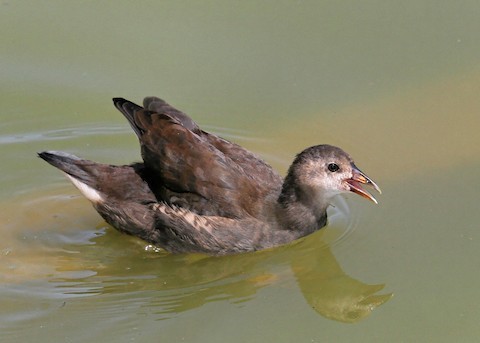
Eurasian Moorhen, immature. (Parc des Oiseaux, Rhône-Alpes, France; July 25, 2012.) © Ian K. Barker

Eurasian Moorhen, immature. (Rome, Italy; September 22, 2012.) © Marco Valentini

Eurasian Moorhen, immature showing unusual lead-gray coloration. (Kaiseraugst, Basel, Switzerland; June 23, 2020.) © Maryse Neukomm

Eurasian Moorhen, immature showing unusually pale plumage—especially on the face and neck. (Zelenogradsky, Kalingrad Oblast, Russia; September 26, 2017.) © Tatyana Korzhitskaya
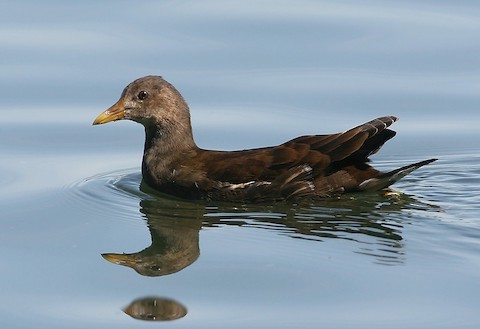
Eurasian Moorhen, subadult. (Eijsder Beemden Nature Reserve, Wallonne, Belgium; August 31, 2009.) © Peter Vercruijsse

Eurasian Moorhen, immature. (Stadtgarten, Essen, Nordrhein-Westfalen, Germany; August 23, 2019.) © Lionel Xavier Horn

Eurasian Moorhen, likely subadult with unusual bill coloration. (Kaiseraugst, Basel, Switzerland; August 5, 2020.) © Maryse Neukomm
Cf. Common Gallinule. The Eurasian Moorhen and its New World counterpart, the Common Gallinule, were traditionally classified as separate species, then for a few decades were widely regarded as conspecific, then in 2011 again formally reclassified as separate. They are extremely similar in appearance, and the visible differences between them are subtle characteristics that vary within each species and overlap between them.
They do not normally occur together, so geographical probability is usually sufficient for identification. However, both are capable of long-distance vagrancy, and it seems likely that they occur in one other’s ranges much more often than the few records would suggest—as their similarities are so strong that most vagrants would go undetected even if studied carefully.
The main differences are: (1) general proportions; (2) size and shape of the frontal shield; (3) vocalizations; and (4) eye color.

Eurasian Moorhen. (Campania, Italy.) © Ciro de Simone

Common Gallinule. (Leonabelle Turnbull Birding Center, Port Aransas, Texas; January 27, 2016.) © Scott Martin
General Proportions: The Common Gallinule averages slightly larger overall than Eurasian Moorhen, but its proportions are lankier and give it the appearance of being significantly larger. Its legs and neck are proportionately longer and its head has a more angular shape—whereas the moorhen appears compact, plump, rounded, and dove-headed. These distinctions are not absolute and are often difficult to evaluate in isolation.

Eurasian Moorhen. (Brüglingen Botanischen Gartens, Basel, Switzerland; October 16, 2019.) © Maryse Neukomm

Common Gallinule. (Peaceful Waters Sanctuary, Palm Beach County, Florida; August 3, 2019.) © David Hall

Common Gallinule, close-up view of broad, flat-topped frontal shield. (Las Gallinas Valley Sanitary District, Marin County, California; March 31, 2018.) © Matt Davis

Eurasian Moorhen, close-up view of small, narrow frontal shield—but with a flatter-than-average top edge. (Phoenixsee, Dortmund, Nordrhein-Westfalen, Germany; February 1, 2019.) © Guido Bennen
Frontal Shield: The most objective and generally consistent visible distinction appears to be the shape of the red frontal shield: the gallinule’s averages larger, broader, and more flat-topped than the moorhen’s—perhaps the best indication is distance to the eye, which is greater on the moorhen. On the Eurasian Moorhen, the sides of the shield are mostly parallel until it curves inward near the upper edge, whereas on the Common Gallinule, its sides tend to broaden and reach distinct corners at the upper edge. However, when comparing frontal shields it quickly becomes apparent that their sizes and shapes vary widely within each species. In particular, the gallinule’s shield starts small, then grows, so an individual with a small shield could belong to either species.
Vocalizations: The moorhen and gallinule are vocally distinct. Both have large repertoires, however, and some vocalizations might be difficult to identify in the field. Both sometimes give sharp squeaks, grunts, and chirps, with no particular pattern—in these cases the gallinule’s notes tend to be higher-pitched. The moorhen characteristically gives percussive polysyllabic or rolling calls (e.g., ti-ti-ti or p-r-r-r-t), whereas she gallinule’s characteristic calls are exuberant cackles and weak trumpets or squeals.

Eurasian Moorhen with a larger-than-average frontal shield—appearing more typical of Common Gallinule. (Slimbridge Wetland Centre, Gloucestershire, England; March 11, 2012.) © Simon Bradfield
Eye Color: Eurasian Moorhen typically shows distinctly reddish irises, whereas Common Gallinule’s eyes typically appear dark-brown. However, eye color varies somewhat, especially in the moorhen, and is subject to strong differences due to lighting.
Notes
Polytypic species consisting of five recognized subspecies.
For several decades, regarded as conspecific with its New World counterpart, the Common Gallinule (galeata), known collectively as the Common Moorhen (G. chloropus) but classified as separate species since 2011.
References
BirdLife International. 2019. Gallinula chloropus (amended version of 2016 assessment). The IUCN Red List of Threatened Species 2019: e.T62120190A155506651. https://dx.doi.org/10.2305/IUCN.UK.2019-3.RLTS.T62120190A155506651.en. (Accessed January 11, 2021.)
Brazil, M. 2009. Birds of East Asia. Princeton University Press.
eBird. 2021. eBird: An online database of bird distribution and abundance. Cornell Lab of Ornithology, Ithaca, N.Y. http://www.ebird.org. (Accessed January 11, 2021.)
Garcia-del-Rey, E. 2011. Field Guide to the Birds of Macaronesia: Azores, Madeira, Canary Islands, Cape Verde. Lynx Editions, Barcelona.
Hollom, P.A.D., R.F. Porter, S. Christensen, and I. Willis. 1988. Birds of the Middle East and North Africa. T & AD Poyser, Calton, England.
Howell, S.N.G., I. Lewington, and W. Russell. 2014. Rare Birds of North America. Princeton University Press.
Mullarney, K., L. Svensson, D. Zetterström, and P.J. Grant. 1999. Birds of Europe. Princeton University Press.
Robson, C. 2002. Birds of Thailand. Princeton University Press.
Sinclair, I., P. Hockey, W. Tarboton, and P. Ryan. 2011. Birds of Southern Africa (Fourth Edition). Random House Struik (Pty) Ltd. Cape Town, South Africa.
Taylor, B., and B. van Perlo. 1998. Rails: A Guide to the Rails, Crakes, Gallinules, and Coots of the World. Yale University Press.
van Perlo, B. 1999. Birds of Southern Africa. Princeton University Press.
van Perlo, B. 2002. Birds of Western and Central Africa. Princeton University Press.
Xeno-Canto. 2021. Common Moorhen – Gallinula chloropus. https://www.xeno-canto.org/species/Gallinula-chloropus. (Accessed January 11, 2021.)
